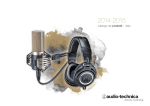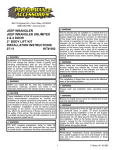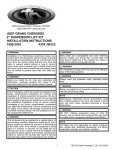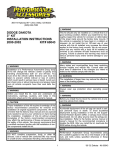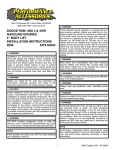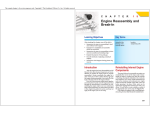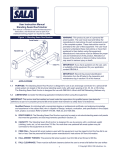Download Nissan 4073 User's Manual
Transcript
WARNING This body lift kit should only be installed on vehicles that are in good working condition. Before the installation begins, the vehicle should be thoroughly inspected for evidence of corrosion or deformation of the sheet metal around the factory body mounts. This body lift kit should not be installed on any vehicle that is suspected to have been in a collision, or misused. Off road use of you vehicle with this body lift installed may increase the stress applied to the factory body mounts. It is not recommended that any vehicle, with a body lift installed, be involved in any extreme off road maneuvers such as jumping. Failure to follow this warning may result in serious personal injury and/or serious damage to your vehicle. WARNING INSTALLATION INSTRUCTIONS 98 NISSAN FRONTIER 2 WD KIT # 4073 WARNING Installation of a Performance Accessories body lift will change the center of gravity and the handling characteristics of the vehicle. Because of the higher center of gravity and larger tires, the vehicle will handle and react differently both on and off road. You must drive it safely! Extreme care must be taken to prevent vehicle rollover or loss of control, which could result in serious injury or death. Avoid sudden sharp turns or abrupt maneuvers and always make sure all vehicle occupants have their seat belts fastened. Performance Accessories strongly discourages the use of a suspension lift kit or any other lift device in addition to a body lift kit. A vehicle that uses a combination of lift devices not originally engineered to be used together may result in unexpected and unsafe handling characteristics. Many states now have laws restricting bumper heights and vehicle lifts. Local laws should be consulted to determine if the changes you intend to make to your vehicle complies with state laws. WARNING The installation of larger wheel and tire combinations may reduce the effectiveness of the Anti-lock Braking System. NOTE Performance Accessories recommends using the Loctite® supplied in the kit, on all hardware unless noted in the instructions. WARNING WARNING Read and understand all instructions, warnings, cautions, and notes in this sheet and in your owners manual before you begin the installation of this body lift kit. CAUTION Proper installation of a Performance Accessories body lift kit requires knowledge of the factory recommended procedures for disassembly an assembly of original equipment components. It is recommended that the factory shop manual and any special tools necessary to your vehicle be on hand during the installation. Installation of this body lift kit without proper knowledge of the factory recommended procedures may affect the performance of these components and the safety of you vehicle. It is strongly recommended that a certified mechanic who is familiar with the installation of similar components install this body lift kit. Always wear eye protection when operating power tools. 1. Read all warnings and instructions completely and carefully before you begin. Check the kit for proper contents (refer to the part’s list and the picture diagrams). Only attempt to install this kit on the vehicle described above. If anytime during the installation you encounter something different from what is outlined in the instructions, call technical support. (520) 6360979. WARNING Make sure that your vehicle is properly blocked and secured before you begin installation of this lift kit. 2. Park the vehicle on a clean, dry, flat, level surface. Block the tires so the vehicle cannot roll in either direction. WARNING The Supplemental Restraint System (SRS, air bag) must be deactivated during installation of the lift kit to avoid accidental deployment of the air bag while working near SRS sensors and wiring. Do not allow anyone near the air bag during installation of the lift kit. Accidental deployment can result in serious personal injury or death. Refer to your factory service manual for the recommended procedure to disable the SRS before installation of lift blocks. The SRS must be reactivated before driving the vehicle. up and out of the bottom mount. Remove the radiator from the vehicle. 3. Disconnect both battery cables. Be sure to disconnect the negative cable first, then the positive cable. Remove the airbag fuse from the fuse box. Consult the owners manual for the exact location of the fuse. 10. Remove the hose from the bottom of the intake and the cruise control mechanism. It will need to be lengthened after the lifting operation is complete. Label this hose to be that it is returned to the correct location. Remove the hose from the vacuum module just in front of the cruise control. 4. Remove the air cleaner housing from the throttle body. Remove the bolts that mount the air duct to the upper radiator mount. Remove the air cleaner and air duct from the vehicle. CAUTION Be sure that the steering shaft does not turn independently of the steering gearbox. This could cause the air bag system to malfunction causing possible personal injury and damage to the vehicle. 5. Mark the steering shaft where it slides into the upper coupler. Mark the lower coupler and the gearbox where the steering shaft slides onto the gearbox splined shaft. This insures proper alignment of the steering after the steering extension has been installed. Remove the bolt that mounts the steering shaft to the upper coupler. Remove the bolt that mounts the steering shaft to the gearbox splined shaft. Slide the steering shaft up and off the gearbox splined shaft, then out of the upper coupler. Remove the shaft from the vehicle. WARNING Use extreme caution when working with the engine cooling system. Never remove the radiator cap from a hot radiator. Wait until the engine and radiator has cooled and the pressure in the system has dissipated. Use care not to spill any antifreeze/coolant while draining system. Antifreeze can be harmful to the environment. Take care to store the drained antifreeze/coolant in a place away from children and animals. Antifreeze/coolant can be fatal if swallowed. 6. Drain the radiator into a clean container. Be sure that the radiator has cooled sufficiently to safely open the cooling system. Remove the fan shroud from the radiator. After the radiator has drained completely, loosen the clamp that mounts the upper radiator hose to the radiator. Remove the hose from the radiator. Loosen the clamp that mounts the lower radiator hose to the radiator. Remove the hose from the radiator. Remove the bolts that mount the fan shroud to the radiator. Remove the bolts that mount the top two radiator mounts to the core support. Remove the mounts from the vehicle. Lay the fan shroud against the engine. Pull the radiator 7. Loosen the two hose clamps that mount both heater hoses to the heater core at the firewall (passenger side). 8. Remove the bolt that mounts the a/c hose to the firewall close to the vacuum brake booster. 9. Remove the hose that connects to the vacuum brake booster from the booster. 11. Disconnect the brackets that mount the steel vacuum lines to the passenger side frame rail from the frame rail. Check along the fender well and under the intake manifold to be sure that there is enough slack in the vacuum lines to allow lifting. Disconnect the lines as necessary. Make a diagram to insure proper reconnection after the lifting operation is complete. 12. Remove the bolt that mounts the engine to body ground wire to the body (passenger side firewall in the bell housing area). 13. Remove the two bolts that mount the cab safety loop to the floorboard (around the drive line through the cross member). 14. Remove the bolt that mounts the parking brake cable to the stock bracket on the cross member under the driver’s side floorboard. Slide the cable out of the opening at the top of the bracket. 15. Remove the two screws (one on each side) that mount the outside of the bumper to the fender. These screws are accessed through the wheel well. Remove the four bolts that mount the front bumper to the frame. Remove the bumper from the vehicle. 16. Remove the tabs that hold the fender well flaps to the frame. This will prevent the flaps from being damaged while lifting. 17. Remove the screws that mount the scuff plate to the door jamb area on both sides of the vehicle. Remove the kick panels from both sides. Place the manual transmission in neutral. Remove the screws that mount the shift boot to the floorboard. Pull the boot back to expose the top of the transmission. Remove the c-clip that holds the transmission shift lever in the top of the transmission. Remove the spacer washer that is under the C-clip. Remove the shift lever from the vehicle. You may want to wrap a rag around the bottom of the shift lever to prevent any oil from dripping on the carpet. Pull the carpeting back to expose the two body mounting bolt access covers. Remove the plastic access covers from the floorboard and discard. Be sure that the transmission is in neutral. Remove the shift lever from the transmission. WARNING Use extreme caution when working near fuel lines and fuel tank. Clean up spilled fuel immediately. Any spark could cause an explosion or fire resulting in serious personal and property damage. 18. Remove the screws that mount the fuel filler neck to the body. Loosen the hose clamp that mounts the filler hose to the fuel tank. Loosen the clamp that mounts the large vent hose to the tank. There are two other hoses attached to the filler neck. They are attached to a small box on top of the filler neck. Looking at the filler neck from the outside of the vehicle, detach the hose on the right from the filler neck. It will be reattached after the lifting operation is complete. Remove the hose on the left from the fuel tank. Remove the entire filler neck and hose assembly from the vehicle. 19. Disconnect the license plate lights from the rear bumper. Remove the six bolts that mount the rear bumper to the frame. Remove the bumper from the vehicle. 20. Measure the distance between the cab and the bed. Record this measurement to insure proper alignment of the cab and bed after the lifting operation has been completed. Remove the bolts at the rear cab mount that mount the body to the side of the rear cab mount. There are two bolts inserted from the inside of the frame mount and are threaded into the body. There are two more bolts that are inserted from the bottom and thread into the mounting pad. When the rear cab bolt is removed, the bracket can be removed. Loosen, but do not remove all six cab-mounting bolts. They are located as follows; in the front fender well, in the front floorboard, and at the rear of the cab screwing up into the cab. The front two mounting bolts are installed from the top and the rear bolt is installed from the bottom. bushing, the frame perch, the stock top bushing, the block, and threading into the nut that is captured inside the body. Reinstall the two bolts that mount the outside support bracket to the bottom of the frame perch. Do not tighten any of the bolts at this time. 22. Repeat step #21 for the driver’s side of the cab. Adjust the cab to bed clearance. Install the outside support plates to the cab using the stock bolts. Attach the outside support plates to the stock outside support brackets using two 7/16” x 1” bolts, four 7/16” SAE washers, and two 7/16” nylock nuts on each side of the cab. Do not tighten the cab-mounting bolts at this time. 23. Loosen, but do not remove all six bed-mounting bolts. Remove the mounting bolts from the passenger side of the bed only. Using a hydraulic jack and a wooden block slowly lift the passenger side of the bed just high enough to place the spacer blocks on the frame. Install the new mounting bolts in the following positions; ½ x 5” at the front bed mount, ½” x 4 ½” at the middle bed mount, and ½ x 5 1/2" at the rear bed mount. The bolts should have a ½” USS (large) washer installed, then the bolt should be inserted through the thick rubber bushing, through the frame, through the thin rubber bushing, through the spacer, and through the bottom support rail of the bed. Install a ½” USS washer and nylock nut on each bolt. Do not tighten at this time. 24. Repeat step # 23 for the driver’s side of the bed. Realign the bed to the cab. Refer to the measurements made earlier. One by one remove each body-mounting bolt. Apply the loctite® adhesive to the bolt according to the loctite® application instructions. Tighten each body mounting bolt to vehicle torque specifications. Refer to vehicle service manual for torque specifications. Repeat this step for all cab and bed mounting bolts. WARNING WARNING Failure to replace the OEM body mounting hardware (except mounting bolts) in the stock locations could result in damage to the vehicle and possible personal injury. 21. Using a hydraulic jack and a wooden block, slowly lift the passenger side of the cab just high enough to put the spacers on the mounting pads. Continually check for any hoses, wires, etc. to be sure that everything is flexing properly and not binding. Be especially careful of the a/c hose at the firewall and the at the core support. Place the spacer block on top of the mounting pad. Using a 3/8" washer in conjunction with the stock washer, install the 7/16" x 7" bolts at the front two mounts (core support and front floorboard) and the 10mm x 180mm bolt at the rear cab mount. For the front two mounts, the 3/8” washer should be installed on the bolt. The bolt should then be inserted from the top through the stock top washer, through the body, the spacer, the factory top bushing, the frame perch, the bottom factory bushing, the stock bottom washer and inserted into the 7/16” nylock nut provided with the kit. The 3/8” washer should be installed on the 10mm bolt, the bolt should be inserted from the bottom through the outside support bracket, the bottom stock Failure to install the steering extension properly could result in loss of steering causing damage to the vehicle and possible personal injury. 25. Install the steering extension into the lower coupler of the steering shaft. Be sure that the extension is installed so the mounting bolt will slide across the flat on the steering extension. Install the stock retaining bolt in the steering shaft. If the bolt will not easily slide across the flat on the steering extension, the extension has been installed incorrectly. Do not tighten the retaining bolt at this time. Extend the mark on the lower part of the steering shaft down onto the extension. Install the upper part of the steering shaft into the upper coupler inside the engine compartment. Be sure to align the marks made earlier. Install the stock retaining bolt in the upper coupler. Align the mark on the steering extension with the mark on the gearbox. Install the steering extension on the gearbox splined shaft. Install the retaining bolt in the steering extension. Do not tighten the retaining bolt at this time. Be sure that all marks are properly aligned and that there is ample engagement at all unions. Apply the loctite® adhesive to the bolt according to the loctite® application instructions. Tighten all steering hardware securely. We recommend the use of loctite or a similar adhesive on all steering hardware. 26. Using the new lower radiator support as a template, Mark the lower core support for alignment of the new support. Align the holes in the new bracket with the stock mounting holes. Mark the core support for proper alignment of the new support after the stock mount has been removed. Using a die grinder or hacksaw cut away the bottom radiator mount from the core support. Be especially careful of the a/c condenser when cutting the sheet metal. Cut to the outside of each mounting hole approximately 1 ½” to 2” and flush with the vertical surface of the core support (allow enough room for the radiator to slide past the remaining sheet metal without hitting). Place the new lower radiator support bracket on the core support. Be sure that the bracket is aligned with the marks made earlier and that the bracket is positioned flush against the core support with the lip resting on top of the core support. Using the bracket as a template, mark the top of the core support through the holes in the bracket. Remove the bracket. Drill a ¼” hole at both locations. Mount the bracket to the core support by install a ¼” x 1” bolt with a ¼” washer through the bracket, and the core support. Install a ¼” washer and nylock nut on the bolt from the bottom of the core support. Tighten the ¼” hardware securely. 27. Install the radiator on the new lower support bracket. Remove the two rubber bushings from the plastic studs on the top of the radiator. Install the rubber bushings into the large hole in the 2” x 3” x 1” rectangular tube. Slide the tube with the rubber bushing onto the studs at the top of the radiator. Reinstall the stock upper radiator mount. The hole in the stock mount should align with the hole in the tube. Mount the tube to the stock bracket using a 3/8” bolt, two 3/8” USS washers, and a 3/8” nylock nut on each side. Do not tighten at this time. Be sure that the radiator is secure. Tighten all radiator mounting hardware securely. Install the fan shroud to the radiator using the stock hardware. Check the fan to fan shroud clearance. Be sure that the fan cannot make contact with the shroud. Tighten the fan shroud mounting hardware securely. Install both radiator hoses to the radiator. Tighten the hose clamps securely. 28. Reconnect the upper heater hose to the heater core at the firewall. It may be necessary to remove the tie wrap around both hoses to gain enough slack to reconnect the upper hose. The lower heater hose needs to be lengthened. Cut the hose below the top bend. Install the 4" heater hose extension. Fasten using two #10 hose clamps. Install the heater hose to the heater core at the firewall. Tighten all heater hose clamps securely. Refill the cooling system as much as possible at this time. It will need to be topped off after the vehicle has been started. 29. Reroute the vacuum brake booster hose over the a/c hose at the firewall. Bend the bracket that mounts the a/c hose to the firewall forward to a 45-degree angle. This should give the hose ample slack. Reconnect the hose to the brake booster. If the line still feels tight, it may be necessary to carefully bend the steel portion of the line to gain more slack in the line. 30. Check the a/c line at the core support. Be sure that there is enough slack in the line to remount it to the core support. If there is not enough slack, carefully bend the line to gain more slack. Be sure that there is ample slack in the line. Install the bolt that mounts the a/c line to the core support. Tighten securely. 31. Disconnect the vacuum that runs between the bottom of the intake and the cruise control mechanism on the passenger side fender well. Cut the hose approximately in the middle. Install the 3" long hose extension between the two pieces of the hose. Install two #6 hose clamps to hold the extension in place. Tighten securely. Reinstall the hose to the bottom of the intake and to the cruise control mechanism. 32. Reroute the hose that was connected to the vacuum module in front of the cruise control. Reroute the hose on the other side of the steel lines that comes up from the frame. This will give enough slack to reconnect to the vacuum module. It may be necessary to carefully bend the steel portion of the line to route it properly. 33. Reconnect the engine to body ground wire to the body. The ground wire can be reconnected to the lower of the two holes in the bell housing area. Tighten the mounting bolt securely. 34. Mount the parking brake cable-relocating bracket to the stock bracket using two 5/16 x 1" bolts, four 5/16" USS washers, and two 5/16" nylock nuts. Mount the parking brake cable to the new bracket using the stock bolt. Remount the two brackets that hold the cable to the bell housing. Tighten all parking brake hardware securely. We recommend the use of loctite or a similar adhesive on mounting hardware. 35. Using two 10mm – 1.25 x100 bolts with a 3/8” washer on each bolt, and the two 3” long tubes mount the cab safety loop to its original location. It may be necessary to bend the loop slightly to align the loop to the mounting holes with the spacer tubes installed. Apply the loctite® adhesive to the bolts according to the loctite® application instructions. Tighten safety loop mounting bolts securely. WARNING Use extreme caution when working near fuel lines and fuel tank. Clean up spilled fuel immediately. Any spark could cause an explosion or fire resulting in serious personal and property damage. 36. Lengthen the fuel filler hose. Cut the filler hose toward the bottom below the first bend. Install the 1 3/4" fuel filler extension between the two sections of the filler hose. Install a #28 hose clamp at each end of the extension. Tighten both hose clamps securely. Remove the large vent hose from the filler neck. Install the new vent hose to the filler neck vent. Install a #10 hose clamp and tighten securely. Remove the small hose attached to the left nipple of the box on the filler neck. Replace it with the 1/4" hose provided in the kit. Install a #6 hose clamp and tighten securely. Install the filler assembly in the vehicle. Using the stock clamp, reconnect the filler hose to the fuel tank. Using a #10 hose clamp, reconnect the large vent hose to the fuel tank. Using a #6 hose clamp, attach the small hose to the fuel tank. Reconnect the remaining small hose to the filler neck. Tighten all hose clamps securely. Install the screws that mount the filler neck to the body. Tighten securely. Replace the fuel cap. 37. Lengthen the transmission shift lever. Scribe a line along the shift lever below the bend. Be extremely careful during this procedure to not damage any of the parts that are attached to the shift levers. Cut the lever into two pieces through the line. Insert the shift lever extension between the two parts of the shift lever. The tapered end of the extension goes toward the bottom. Both parts of the shift lever should slide into each end of extension. Be sure that the lever is all the way in the extension. Using the holes in the extension as a guide, mark the shift lever for drilling. Drill a 1/8” hole through each part of the shift lever. Reinstall the shift lever into the extension. Align the holes in the extension with the holes in the shift lever. Install a 1/8” x ¾” roll pin at both ends of the extension. 38. Replace the shift lever in the vehicle. Insert the transmission shift lever into the top of the transmission. Be sure that it is all the way in replace the cover. Install the spacer shim. Install the retaining clip. Check the shift lever operation. Be sure that there is complete engagement in all gears. Replace the shift boot and housing assembly. Tighten all mounting screws securely. Check the shift lever operation again. 39. Replace the carpet and matting to its original position. Replace both kick panels and both doorjamb scuff plates. Tighten the mounting screws securely. 40. Using the stock bolts, mount the front bumper brackets to the frame. Tighten the mounting bolts so the brackets cannot move, but so the bumper can still be adjusted. Slide the front bumper onto the relocating brackets. Align the holes in the stock bumper brackets with the holes in the new bumper brackets. The rear leg of the stock bracket will need to be trimmed to clear the bend in the bracket. Mark the bottom of the rear leg where it contacts the bend on the new bracket. The bottom valance will need to be notched around the frame horns. Mark the valance around the frame horns. Remove the bumper from the vehicle. Trim the rear leg on the stock bumper brackets. The cut should go through the bottom of the mounting hole. Notch the valance to clear the frame horns. Reinstall the bumper on the vehicle. Mount the bumper to the relocating brackets using two 7/16” x 1" bolts, four 7/16” USS (large) washers, and two 7/16" nylock nuts. Adjust the bumper to body clearance. Tighten all bumpermounting hardware securely. We recommend the use of loctite or a similar adhesive on all mounting hardware. Reconnect the wires to the driving lights. 41. Reinstall the grill to the core support. Tighten all mounting screws securely. WARNING Raising the rear bumper is intended to enhance the appearance of the vehicle only. The rear bumper will no longer be rated for towing of any kind. Attempting to tow with the rear bumper after it has been raised can result in damage to the vehicle and possible personal injury. A class III receiver hitch must be installed in order to tow with the vehicle after the rear bumper has been raised. 42. Install the rear bumper. If you wish to tow with the rear bumper, reinstall the bumper in the stock location using the stock brackets and mounting hardware. To raise the rear bumper, remove the two bolts that mount each rear bumper bracket to the bumper. Drill a new mounting hole in the bumper side of the stock bumper bracket according to the diagram. Hold the bumper bracket against the frame in the stock location. Pivot the rear of the bracket upward until the last hole on the bracket is aligned with the bottom of the slotted hole in the frame. The first hole in the bracket should still align with the last stock hole in the bumper. The center mount hole should also align with a hole in the frame. Mount the brackets to the frame using the 7/16” x 1” bolts, 7/16’ USS washers, and 7/16” nylock nuts provided. Do not tighten. Mount the bumper to the holes specified in the diagram using the 7/16” x 1” bolts, 7/16’ USS washers, and 7/16” nylock nuts provided. The rear bumper should align with body. Adjust the bumper to body clearance. Tighten all bumpermounting hardware securely. We recommend the use of loctite or a similar adhesive on all mounting hardware. Reconnect the license plate lights to the bumper. 43. Reinstall the air cleaner. If the vehicle is equipped with a/c, the back right corner of the housing must be notched to clear the a/c line at the firewall. Trim the bottom of the housing just to the left of the corner just enough for the a/c line to clear. Install the bottom part of the housing. Reconnect all houses that were disconnected at the beginning of the installation. Trail fit the top of the housing. Mark the top where it makes contact with the a/c line. Notch this section of the top housing. Install the top of the housing. Install the air intake duct to the upper radiator mounting brackets. Install the mounting screws and tighten securely. WARNING All welding should be performed by a certified welder only. 44. Install the four bed overload pads on the frame over in the wheel wells. There should be two places on each side where the bed rested on the frame, but was not mounted to the frame. This is where the overload pads go. The pads need to be tack welded to the frame only. 45. Reconnect both battery cables. Be sure to reconnect the positive cable first, then the negative cable. Reinstall the airbag fuse if equipped. 46. Place the warning sticker on the dash in plain sight of all vehicle occupants. CAUTION All fasteners should be retorqued after 500 miles and after off road use. All body lift components should be visually inspected and fasteners retorqued during routine vehicle servicing. 47. Double-check the vehicle. Check all mounting hardware to be sure that it is properly tightened. Check all wires, hoses, cables, etc. to be sure that there is ample slack. Check the vehicle electrical system. Start the vehicle. Check the steering in both directions to be sure that there is no bind. Check clutch operation. Check the operation of the brake system and the parking brake. Check both shift levers’ operation. Be sure that there is proper engagement in all gears and 4 wheel drive ranges. Check coolant level. Caution: never open a closed cooling system after the vehicle has been started. Only fill the cooling system if the cap has been removed while the vehicle was still cold. Fill the coolant to the proper level. Reinstall the radiator cap. Carefully check all hoses to be certain that they have been connected properly and that there is ample slack. With the amount of hoses on this vehicle, it is vital that this be checked thoroughly. Test-drive the vehicle in all gears and 4 wheel drive ranges. Pay very close attention to all vehicle systems. Check all hardware again in 500 miles and as part of your regular maintenance schedule. CAUTION Performance Accessories does not recommend any particular wheel and tire combinations for use with its body lifts and can not assume responsibility for the customers choice of wheels and tires. Your owner's manual can be referenced for recommended tire sizes and warnings related to the use of oversized tires. Larger wheel and tire combinations increase stress and wear on steering and suspension components, which leads to increased maintenance and higher risk for component failure. Larger wheel and tire combinations also alter speedometer calibration, braking effectiveness, center of gravity, and handling characteristics. Consult with an experienced local off road shop to find what wheel and tire combinations work best with your vehicle. NOTE All warranty information, instruction sheets, and other documents regarding the installation of this product must be retained by the vehicle owner. Information contained in the instructions and on the warranty card will be required for any warranty claims. The vehicle owner needs to understand the modifications that have been made to his vehicle and how they affect the handling and performance of the vehicle. Failure to provide the customer with this information can result in damage to the vehicle and possible personal injury. PARTS LIST Kit 1 2 1 1 2 1 1 1 1 1 6 6 2 4 1 1 Transmission shifter extension bracket Front bumper brackets Lower radiator support bracket Parking brake cable relocation bracket Outside cab support brackets 1 3/4" x 3" fuel-filler extension 1/2" x 19" fuel vent hose 1/4" x 17" fuel vent hose Warning to driver sticker Logo label 3x3 blocks 3x2 blocks 2x3 spacers with holes 2x3 spacers without holes 10ml bottle Loctite 262 Bolt pack BP4073 4 7/16" x 7" bolts 2 10mm x 180mm bolts 2 1/2" x 4 1/2" bolts 2 1/2" x 5" bolts 2 1/2" x 5 1/2" bolts 6 Thick 1/2" USS washers 6 1/2" USS washers 6 3/8" SAE washers 4 7/16" nylock nuts 6 1/2" nuts 1 se 9000 steering extension 1 3/8" x 1 1/4" socket head bolt 1 Hardware Pack HP4073 Bolts 16 7/16" x 1" bolts 2 10mm x 100mm bolts 2 3/8" x 1" bolts 2 5/16" x 1" bolts 2 1/4" x 1 " bolts Washers 8 7/16" SAE washers 24 7/16" USS washers 4 3/8" SAE washers 4 5/16" USS washers 4 1/4" SAE washers Nuts 16 7/16" nylock nuts 2 3/8" nylock nuts 2 5/16" nylock nuts 2 1/4" nylock nuts Miscellaneous 4 2 2 2 1 1 2 #6 hose clamps #10 hose clamps #28 hose clamps 3/8" x 3" scd. 40 cab safety strap 3/8" x 4" scd. 40 heater hose extension 7/16" x 3" .049" vacuum hose extension 1/8" x 3/4" roll pins








